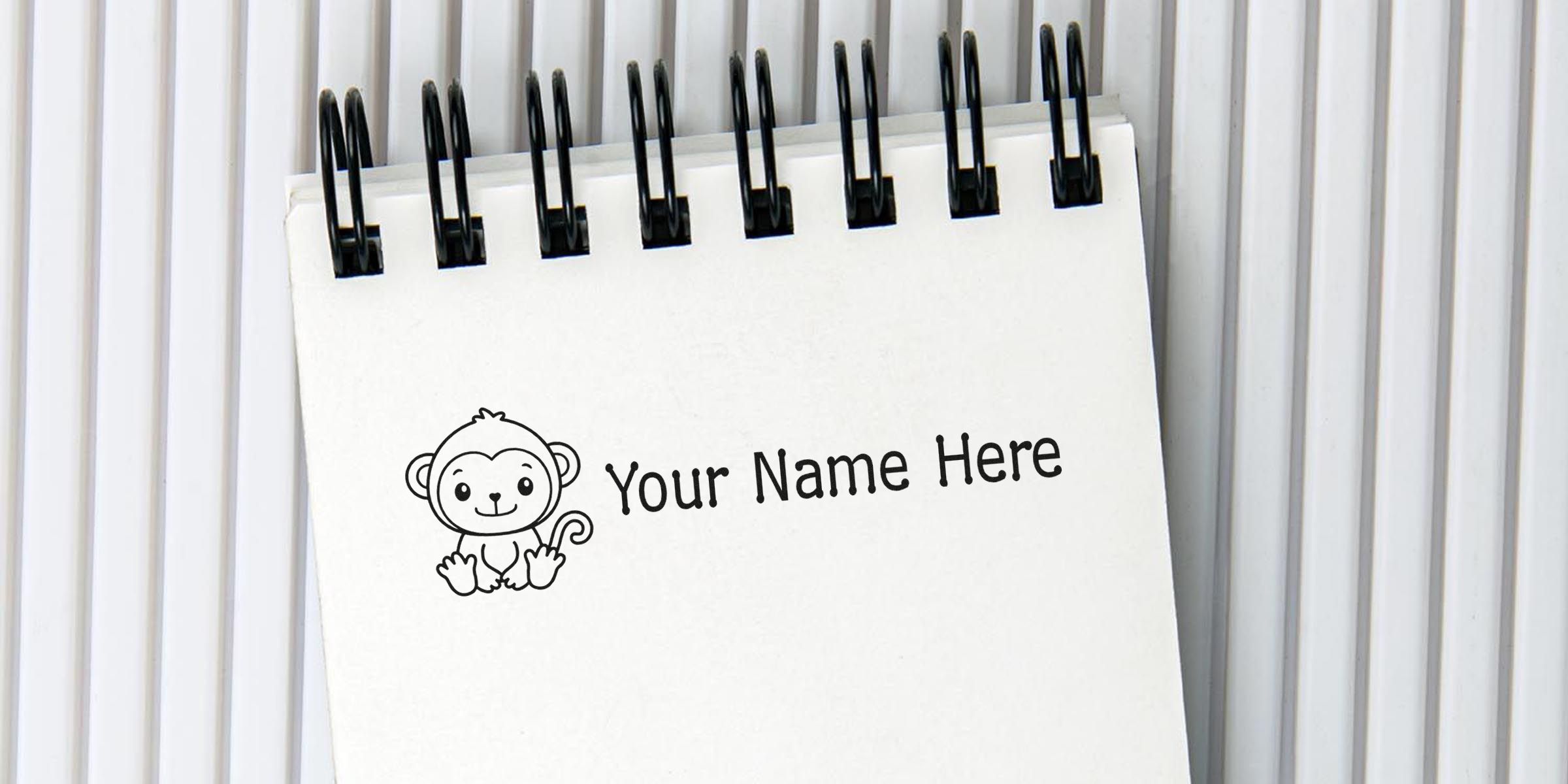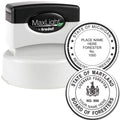Meet Your Clothes Marking Companion
If you’re tired of losing track of clothes at school, camp, or even at home, a self-inking clothing stamp can save you plenty of hassle. This handy tool prints your name—or any custom text you want—directly onto fabric without the need for separate ink pads or messy markers. It’s a convenient solution that offers a crisp, legible impression every single time.
In this guide, you’ll learn how self-inking stamps work, which features matter most, and how to pick the perfect option for your situation. Ready to keep track of your family’s clothes, or mark items for your small home business? Let’s jump right in.
How a Self-Inking Clothing Stamp Works
Picture popping open a little gadget that’s slightly bigger than your palm. Inside, you’ll find both the ink reservoir and a smooth rubber die (the customizable part that holds your message). When you press down on the body of the stamp, a small mechanism transfers ink from the reservoir to the die, then imprints it onto your fabric.
The Basic Mechanics
- A built-in ink pad sits above the rubber die.
- When you press down, the die flips briefly onto the pad and then onto your fabric.
- After the impression, the die flips back into place, re-inking itself for the next stamp.
This effortless cycle ensures you can stamp multiple items in quick succession. Think of labeling a stack of T-shirts for an upcoming sports camp—just press, lift, and move on to the next shirt. No more fiddling with separate ink pads or running out of marker mid-label.
Why Use a Self-Inking Clothing Stamp?
You might ask, “Can I just scribble my name with a permanent marker?” Sure, but that often leads to uneven writing, fuzzy lines, or fading after a few washes. Self-inking stamps, especially those designed for fabric, are built to stay sharp longer.
Consistency
Every impression will look the same, which is ideal if you’re labeling uniforms or items for multiple kids.Time-Saving
No need to repeatedly recapture ink. You literally flip, press, and you’re done.Long-Lasting Results
The ink is formulated to bind well with fabric fibers, meaning it doesn’t wash out easily.Customizable
You can personalize your stamp with different text or even an icon. This is a fun option for kids who want a symbol next to their name.
Key Features to Consider
When picking a stamp, you’ll want to pay close attention to certain features. Let’s break these down so you know exactly what to look for.
1. Stamp Quality
- Durability: A self-inking stamp gets pressed over and over. Make sure the body (often plastic or metal) can handle repeated use without breaking.
- Re-inking Potential: Some brands let you add more ink once it starts to fade. This extends the life of your stamp—and saves you money over time.
2. Custom Design Options
- Text and Font: Do you want just a name or a name plus a phone number? Check if the stamp allows multiple lines. Also, be aware that some manufacturers have size limits, so verify how many characters fit.
- Clip Art or Logos: If you’re using your stamp for a small business, you might want a mini logo. Make sure the stamp company can handle that detail.
3. Type of Ink
- Fabric-Friendly Ink: Not all ink works on all fabrics. Look for stamps specifically labeled for cloth marking. They typically use non-toxic, fast-drying ink that’s safe on skin (just in case).
- Fade-Resistance: Is it washing-machine safe? High-quality ink resists fading, even if you’re sending clothes through multiple laundry cycles each week.
4. Stamp Size
- Imprint Dimensions: Larger stamps might hold more text, but they can also appear bulky. Smaller stamps, meanwhile, fit nicely on tags or hem areas.
- Portability: Do you plan to take the stamp on the go? Some are designed to be compact for easy travel, which is perfect if you need to label items at events or craft fairs.
5. Ease of Use
- Comfortable Grip: A smooth handle or casing can make stamping 50 items in a row a breeze.
- Alignment Guides: Some stamps have a transparent base or guidelines indicating where your imprint will land on the fabric.
Choosing the Right Stamp for You
Turning your focus to the right product can feel daunting when there are countless options on the market. Let’s make it simpler by pinpointing what truly matters for your needs.
Assess Your Application
Start by considering when, how, and on what materials you’ll stamp:
- Is this purely for labeling kids’ clothes for school or camp?
- Do you run a small business that ships out clothing items with branded marks?
- Will you use it occasionally or daily?
The frequency and environment in which you’ll use your stamp guide the decision. For example, frequent stamping might call for a higher-end product with a sturdy build.
Best Use Cases
- Personal Use: Label your family’s jackets, T-shirts, socks, or even cloth napkins.
- Small Businesses: Add a signature logo to cloth bags, aprons, or promotional items.
- Events and Fundraisers: Mark T-shirts or cloth-based giveaways quickly.
Consider ESS for Your Cloth Marking Needs
If you’re looking for a straightforward, reliable supplier, ESS might be your go-to. ESS has been a family owned and operated business since 1964, offering top-quality cloth marking stamps, name stamps, and other fabric stamp solutions. With 60 years of service, they’ve solidified a reputation for stellar customer service and super fast turnaround times. Whether you want a specialized self-inking clothing stamp or just need help picking the right ink, ESS is happy to guide you.
Tips for Getting the Most Out of Your Stamp
Once you’ve picked your product, getting optimal results is all about technique and upkeep. Here are a few pointers to ensure each imprint stays clean and bright.
1. Test on Scrap Fabric
Before stamping that brand-new jacket, try one practice run on a spare piece of cloth or inconspicuous spot. This helps you check alignment and ink coverage.
2. Stamp on Smooth Surfaces
Wrinkles can cause uneven imprints. Smooth out the fabric—or stretch it lightly—before stamping. For delicate materials (like silk), you may want to place a small cardboard piece behind the fabric to keep it taut.
3. Store the Stamp Properly
When you’re finished, store your self-inking stamp in a cool, dry spot. Avoid leaving it in direct sunlight or extreme heat, which can dry out the ink faster.
4. Keep Ink Levels in Check
If your stamp allows refills, watch for signs of fade. Once the print starts looking faint, add a few drops of compatible ink. Over-inking can cause smudges, so apply just enough to revive the clarity.
5. Wash and Dry Clothes Normally
Most fabric-friendly inks hold up in the washing machine. Still, it’s not a bad idea to keep an eye on whether your impression is fading after several washes. If it does, consider giving it a quick re-stamp.
Common Mistakes to Avoid
Even a well-designed self-inking clothing stamp can’t fix every mistake. Here are some pitfalls you’ll want to dodge:
- Using Regular Ink on Fabric: Inks formulated for paper may run, fade, or weaken certain cloth types. Always go for fabric-specific ink.
- Applying Too Much Pressure: If you press down too hard, you might smudge the design or cause excess ink to transfer beyond the edges.
- Ignoring Stamp Maintenance: A dry or clogged stamp doesn’t produce good results. Refill promptly and keep the die area clean.
- Stamping on Wet Fabric: Water can smear your imprint, so ensure clothes are fully dry before you begin.
- Skipping Measurements: If you plan to include more than one line of text (like a name and phone number), confirm the stamp size. Overstuffing the stamp area might compromise legibility.
FAQs About Self-Inking Clothing Stamps
Below are some common questions you might have before you make that purchase:
-
Will the Ink Wash Out or Fade Quickly?
High-quality products designed for fabric resist frequent washes. Over time, you might notice mild fading, especially with repeated hot-water cycles, but it usually stays legible for dozens of washes. Can I Stamp on Any Type of Fabric?
In general, yes. However, extremely stretchy or plush materials (like certain fleece pajamas) may produce a blurrier mark. Consider testing on a hidden area first to see how well the ink adheres.Do I Need a Separate Ink Pad?
Since you’re looking at self-inking models, you won’t need an external pad. Everything is built right into the stamp body, making it simple to use on the spot.How Long Does a Single Ink Fill Last?
It varies by brand and usage frequency. For moderate home use, you could go months (or even longer) before noticing any fading. When it does start to lose brightness, simply add recommended refill ink.Why Choose ESS Over Other Brands?
ESS has 60 years of experience in the cloth marking business. They’re known for stellar customer service, super fast turnaround times, and a wide range of customizable options. They can handle everything from a basic name stamp to a more elaborate design that suits your small business.
Take the Next Step
Choosing a self-inking clothing stamp frees you from laundry mix-ups, lost camp T-shirts, and time spent handwriting every single label. By paying attention to features like ink quality, stamp size, and user-friendliness, you can make a choice that fits your needs perfectly. And if you’re looking for a trusted brand, consider ESS. They’ve been around for decades—literally—offering reliable, high-quality stamps that make your life easier.
Take a moment now to envision your organized drawers and neatly labeled items. Once you add such a stamp to your toolkit, you’ll wonder how you ever got by without it! If you’re curious about additional options, check out a fabric stamp too, so you can compare different marking methods. Whichever route you pick, you’ll be set to keep track of family items, business inventory, or craft projects with ease.
Feel free to share your own tips or experiences in the comments. Happy stamping!


















